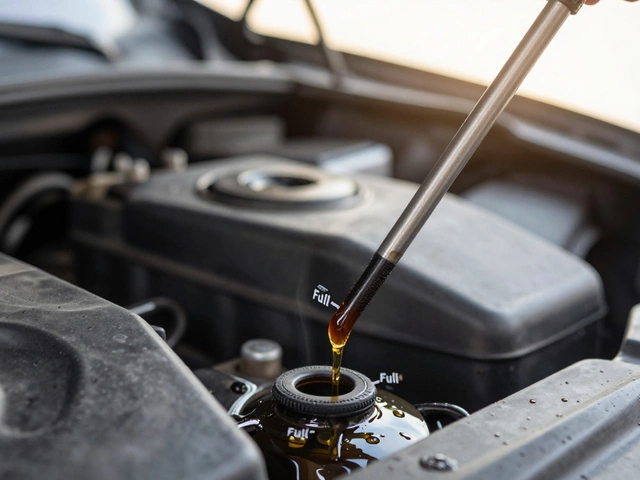
Ever wonder if your spark plugs are still doing their job, or if they're barely hanging on? Here’s the deal: most spark plugs are built to go anywhere from 20,000 up to 100,000 miles, but not all plugs—or driving styles—are created equal. You can’t just slap in a new set and forget about them forever.
Modern cars usually stretch the life of their plugs because of better materials and smarter engines. Still, stop-and-go traffic, short trips, and rough idling can cut that lifespan shorter than you’d expect. Plus, the type of spark plug under your hood—copper, platinum, or iridium—makes a real difference in how long they last and how often you’ll be reaching for your tool kit.
Ignoring spark plug issues is a recipe for all kinds of headaches, like sluggish starts, wasted fuel, or even bigger engine problems. Swapping them out on time keeps your car firing strong and can save you a surprise at the repair shop later down the road.
- What Really Determines Spark Plug Lifespan?
- Signs Your Spark Plugs Need Changing
- Types of Spark Plugs and Their Mileage
- How to Make Spark Plugs Last Longer
- What Happens If You Ignore Old Spark Plugs?
What Really Determines Spark Plug Lifespan?
There’s no single “magic number” for how many miles your spark plugs will last. Instead, it’s a mix of stuff most folks don’t even think about until their car starts acting up. The type of spark plug you use makes a massive difference—not all plugs are built equal. Copper ones burn out faster, maybe around 20,000-30,000 miles, while iridium can hang in there for up to 100,000 miles in some engines. Platinum sits right in the middle.
But plug type is just the start. How and where you drive matters more than you’d think. Short, quick trips (like a lot of city driving) mean your engine doesn’t always get warm enough, shortening plug life. If you mostly do highway miles, your plugs run cleaner and last longer. Tinkering with your car—like engine modifications or running it hard all the time—also wears them out quicker.
Don’t forget about your engine’s actual design, either. Some engines run hotter or are known spark plug eaters, so always check your owner’s manual for what’s normal for your car or truck.
Here’s a look at the typical lifespan based on plug type:
| Spark Plug Type | Typical Lifespan (miles) |
|---|---|
| Copper | 20,000 – 30,000 |
| Platinum | 60,000 |
| Iridium | 80,000 – 100,000 |
Check out these main things that can speed up spark plug wear:
- Low-quality fuel or oil leaks
- Poor air filters
- Too much idling
- Improper spark plug gap
- Using the wrong spark plug type for your car
If you really want to maximize spark plug life, keep up with regular car maintenance—clean air filters, fix leaks, and use the plugs your car’s maker recommends. Sometimes, just paying attention to how your car feels can clue you in before things get worse.
Signs Your Spark Plugs Need Changing
Not sure if your spark plugs are over the hill? Your engine usually tries to tell you. Knowing these signals can save you money and hassle.
- Rough Starts: If it feels like your car is struggling to get fired up, those plugs might be failing at their main job—sparking the ignition.
- Engine Misfires: Notice your engine jerking or skipping beats while accelerating? This means the spark isn’t firing right. Even one bad spark plug can cause this.
- Poor Fuel Economy: Tank not taking you as far as it used to? Worn spark plugs make your engine burn more fuel just to keep running.
- Lack of Power: Does your car feel like it’s lost its get-up-and-go? That’s another sign. Bad plugs mean weak or inconsistent sparks, and your engine just can’t deliver.
- Engine Idling Roughly: Instead of a smooth hum, your engine shakes, rattles, or sounds uneven when stopped at lights. Healthy plugs keep it running smooth.
- Check Engine Light: Sometimes your car will flat-out tattle—modern vehicles can sense misfires and will throw a check engine light if something’s off.
If you want hard numbers, here’s what people often report when spark plugs are overdue for a swap:
| Symptom | Average MPG Loss | Occurrence Rate |
|---|---|---|
| Poor Acceleration | Up to 30% | High (seen in most cases) |
| Engine Misfire | N/A | About 55% |
| Hard Starting | N/A | About 40% |
| Check Engine Light | N/A | About 30% |
Here’s a quick tip: If your car has passed the recommended mileage for spark plug life or you notice more than one of these issues, it’s probably time to check or replace them. Small investment, big difference!

Types of Spark Plugs and Their Mileage
When it comes to spark plug life, the material makes a huge difference. Not all spark plugs are created equal—some are built for the long haul, while others burn out faster. Here’s the breakdown:
- Copper Spark Plugs: These are the old-school standard, usually what you’ll find in older or high-performance engines. They’re cheap and offer solid spark, but they only last about 20,000 to 30,000 miles. If your mechanic says you need new spark plugs more often, chances are you’ve got copper ones.
- Platinum Spark Plugs: These are the middle ground. They’re a bit pricier, but they last longer—up to 60,000 miles. Cars with distributor-based ignition systems often take these because they handle heat and wear better than copper.
- Iridium Spark Plugs: Think of these as spark plug royalty. Iridium is crazy tough (eight times harder than platinum) and they can last 80,000 to 100,000 miles or even more in some engines. Most modern engines come with these right from the factory.
- Double Platinum: These are even better for wasted spark ignition systems. Both electrodes are platinum, so they can outlast single platinum in certain engines—often close to 100,000 miles.
Check out how these types stack up side by side:
| Spark Plug Type | Average Lifespan (Miles) | Common Use |
|---|---|---|
| Copper | 20,000 - 30,000 | Older/high performance engines |
| Platinum | 40,000 - 60,000 | Distributor-based systems |
| Double Platinum | Up to 100,000 | Wasted spark systems |
| Iridium | 80,000 - 100,000 | Modern engines |
Here’s a quick tip: Always match the plug to your vehicle’s engine and the way you drive. Just because iridium plugs last longest doesn’t mean you should pop them in an old engine made for coppers. You’ll get the best performance—and the right spark plug life—by sticking to your car’s recommended type and swapping them out before they’re totally shot.
How to Make Spark Plugs Last Longer
If you want more miles between spark plug changes, a few smart habits can make a big difference. Your spark plug life isn’t just set by the part itself—what you do behind the wheel and under the hood matters a lot. Let’s break down what actually helps.
- Pick Quality Plugs: Choose iridium or platinum plugs if your car can use them. Iridium plugs, for example, can last over 80,000 miles, while basic copper ones often tap out after 20,000–30,000.
- Stick to the Maintenance Schedule: Look up your owner’s manual and write down the recommended interval. Don’t guess—manufacturers know what’s best for your engine.
- Keep Your Engine Tuned: An engine running too rich or with weak ignition can foul plugs fast. Regular oil and filter changes help too.
- Check for Leaks: Oil or coolant leaks can trash spark plugs. Fix any valve cover leaks before they have a chance to cause damage.
- Don’t Ignore Warning Signs: Hesitations, rough starts, or a drop in fuel mileage all mean your plugs or something upstream needs attention.
Hot weather, a lot of city driving, and repeated short trips can all shorten spark plug lifespan. Try to occasionally get your engine up to highway temperature with a longer drive—this helps burn off deposits.
| Spark Plug Type | Average Lifespan (miles) | Best Use Case |
|---|---|---|
| Copper | 20,000–30,000 | Older engines, cheap replacements |
| Platinum | 60,000 | Everyday driving, newer cars |
| Iridium | 80,000–100,000 | Long intervals, modern engines |
If you’re already getting your money’s worth out of every plug, great. But if you’ve been picking cheap copper plugs and skipping tune-ups, you’ll end up spending more in the long run. A little prevention keeps your plugs—and your whole ignition system—running smooth and trouble-free.

What Happens If You Ignore Old Spark Plugs?
If you think an old spark plug can just hang out forever, think again. When spark plugs wear out, they can cause all sorts of annoying and expensive problems for your car—and your wallet.
First up, your car may start to misfire. That’s when the engine gets the timing wrong or skips burning fuel smoothly. You’ll notice it as rough idling, jerky starts, or that "chugging" feeling when you hit the gas. If you ignore misfires, they stress other pricey components, like your catalytic converter.
Worn spark plugs also mess with your car’s fuel economy. According to the U.S. Department of Energy, a misfiring spark plug can drop your miles-per-gallon by as much as 30%. So, you’re literally burning money every time you fill up.
- Poor acceleration
- Hard starts in cold or even normal weather
- Unstable or rough idling
- Check engine light flashing or staying on
If you let things go too long, you risk engine misfires turning into major repairs. Unburned fuel can overheat and wreck your emissions system. The cost of ignoring spark plug life goes way beyond just spark plugs themselves.
| Problem | Potential Cost (USD) |
|---|---|
| Reduced fuel efficiency | $100–$300/year (extra fuel) |
| Catalytic converter damage | $950–$2,500 |
| Failed emission test | $30–$150 (plus repairs) |
So if you’re seeing sluggish performance, burning through gas, or dealing with warning lights, those old spark plugs aren’t just an inconvenience—they’re a disaster waiting to happen. Swap them out before things spin out of control.





